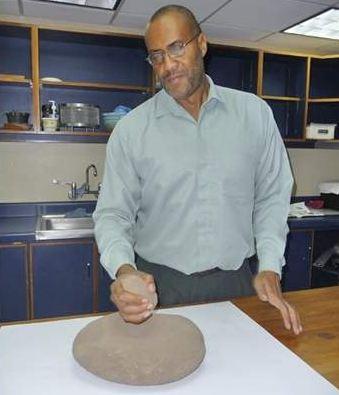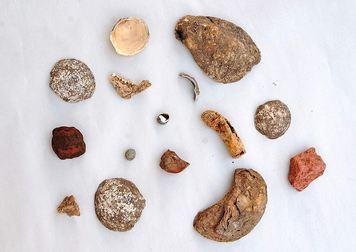7,000-year-old settlements unearthed at Avocat
Richard Charan
Source - http://www.trinidadexpress.com/20150720/features/the-caribbeans-first-farmers
 Rarity: Senior Lecturer at the UWI's Department of History Dr Basil Reid, with some of the artefacts found at the St John's Trace site.
Rarity: Senior Lecturer at the UWI's Department of History Dr Basil Reid, with some of the artefacts found at the St John's Trace site.
While modern-day Trinidadians squabble over the issues of the New World's European rediscovery five centuries ago and the plantation economy from which we all emerged, here is a reminder that every last one of us is a descendant of migrants who arrived in a place which, long before, had a complex society.
The island was already settled for thousands of years, so long ago that archaeologists have found evidence of the 7,000-year-old settlements of the first citizens – the Ortoiroids, who canoed across from South America, and travelled upriver into the Oropouche wetlands.
Two of the most significant sites in Trinidad are at Banwari Trace, San Francique, and St John's Trace, Avocat, locations that, in a more enlightened country, would have been set aside as protected places of learning, research and scholarship.
Banwari Trace, where the famed Banwari man was found in 1969, is watched over by a volunteer custodian, with talk of its future development seemingly having died along with Peter Harris (who passed away in 2013), the archaeologist credited with discovering the site.
Five kilometres away at St John's Trace, the site has no State protection, threatened once before by bulldozers and at the mercy of private owners at a time when land is like gold.
It is here at the St John's Trace site that Dr Basil Reid, Senior Lecturer in Archaeology at the Department of History of The University of the West Indies, spent time between 2009 and 2011 with a team from the Archaeology Unit.
What Dr Reid and his team discovered, the findings of which were published last week, will rewrite the history books about what we know of the Caribbean's first people.
 The dig unearthed a midden with shells and the bones of fish and mammals, including the collared peccary (pig) nine-banded armadillo, paca (agouti) and red brocket deer, telling us of the diet of the settlers, and similar to what had been found at Banwari Trace.
The dig unearthed a midden with shells and the bones of fish and mammals, including the collared peccary (pig) nine-banded armadillo, paca (agouti) and red brocket deer, telling us of the diet of the settlers, and similar to what had been found at Banwari Trace.
However, the real prize came with the discovery of three milling stones, used to process food by rubbing, grinding, or pounding, and two conical pestles used for mashing or grinding substances.
The artefacts were sent to the Department of Biology at the University of Puerto Rico, where the sediments containing starch grains trapped in the fissures and pores of the stones were removed. The starch grains, which survived thousands of years, were analysed under powerful microscopes, so that the plants they came from could be identified.
Dr Reid's work was published in the peer-reviewed Quaternary Science Reviews. He reported that the analysis of the St John's site artefacts found they contained the starch grain of maize (corn), sweet potato, chilli pepper, bean, marunguey (a root from which a bread was made) achira (another tuber), marantaceae (arrowroot) and wild yam.
Dr Reid, the author of Myths and Realities of Caribbean History and co-author of the Encyclopedia of Caribbean Archaeology, considers it an important discovery for Trinidad and Tobago.
Radiocarbon dating has found that the St John's site is older than Banwari Trace, which makes it the oldest known settlement in the southern Caribbean or north eastern South America, where maize and other crops were cultivated.
The first farmers of the Caribbean started right here.
More about St John's site
St John is located south of the Godineau River in Trinidad in close proximity to the South Oropouche mangrove swamp. The site is a relatively deep shallow shell midden about 1.2 metres (4 feet) deep, with a maximum diameter of 38.1 metres (125 feet). At the western end, exposed strata show that each is characterised by a predominance of different mollusc species. In 1924, JA Bullbrook collected shells and mammal bones at the site. In 1953, Bullbrook and Irving Rouse relocated the site, and Rouse, Bullbrook and colleagues excavated a trench that yielded Arauquinoid ceramics in the uppermost level. Materials retrieved from these 1953 excavations are housed at the Peabody Museum, Yale University. Over the years, hammerstones and celts have been discovered at St John. A radiocarbon assay of the site in 1994 yielded a C14 date of 6672±48 BP, which, when calibrated, is 5470-5290 BC.
In February and March 2009, October 2009, March and April 2010, and February, March and April 2013, and as recently as February to May 2015, surveys and excavations were undertaken at the St John site in southwestern Trinidad. Spearheaded by the Archaeology Unit in the Department of History at The University of the West Indies, St Augustine, the project was made possible by the involvement of UWI undergraduate history/archaeology students and a handful of volunteers. Of major significance was the retrieval of four grindstones and three pestles from 2009 to 2013. These artefacts clearly intimate that plant materials were processed at this site and, by extension, the existence of early Ortoiroid farming (a Reid discovery). Many of the ground stone tools appear to have been used for pounding and processing hard or fibrous vegetable material.
An abundance of shells, mammal bones, and stone artefacts (including flakes, pestles and grindstones) were recovered from the site. This suggests that the Ortoiroid, who inhabited St John approximately 7,000 years ago, used a judicious combination of strategies for getting food and exploited a range of resource habitats in close proximity to the site. Like Banwari Trace, the archaeological remains at St John suggest that there was little use of deep-sea resources. In addition, there was a general shift from the use of terrestrial animals toward the use of foods from marine environments, particularly inshore and estuarine species. Bone tools, primarily sharpened bone tips for hunting or fishing spears, have been preserved at St John in large numbers. They range from about two to 15 centimetres in length.